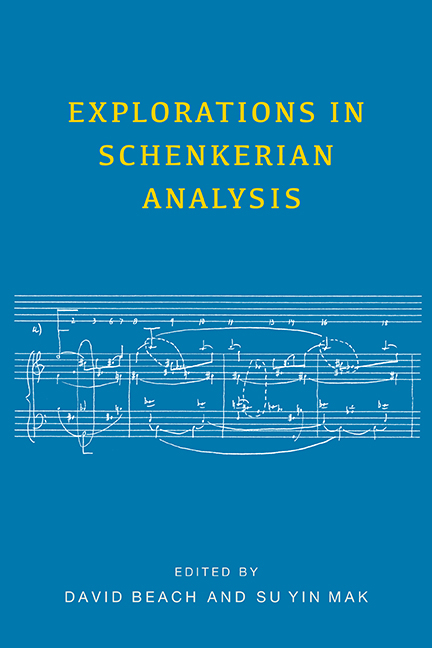Book contents
- Frontmatter
- Contents
- Preface
- Part One Eighteenth Century
- Part Two Early Nineteenth Century
- Part Three Late Nineteenth Century
- 11 Half-Diminished-Seventh Openings in Brahms's Lieder
- 12 Motivic Enlargement in Dvořák's Symphony Op. 70
- 13 Deliverance and Compositional Design in the “Libera me” of Verdi's Messa da Requiem
- 14 Polyphony and Cacophony? A Schenkerian Reading of Strauss's “Dance of the Seven Veils”
- 15 A Force of Nature: Debussy and the Chromatically Displaced Dominant
- Appendix: An Interview with Edward Laufer
- List of Contributors
- Index
14 - Polyphony and Cacophony? A Schenkerian Reading of Strauss's “Dance of the Seven Veils”
from Part Three - Late Nineteenth Century
Published online by Cambridge University Press: 28 June 2018
- Frontmatter
- Contents
- Preface
- Part One Eighteenth Century
- Part Two Early Nineteenth Century
- Part Three Late Nineteenth Century
- 11 Half-Diminished-Seventh Openings in Brahms's Lieder
- 12 Motivic Enlargement in Dvořák's Symphony Op. 70
- 13 Deliverance and Compositional Design in the “Libera me” of Verdi's Messa da Requiem
- 14 Polyphony and Cacophony? A Schenkerian Reading of Strauss's “Dance of the Seven Veils”
- 15 A Force of Nature: Debussy and the Chromatically Displaced Dominant
- Appendix: An Interview with Edward Laufer
- List of Contributors
- Index
Summary
Heinrich Schenker was never one to mince words, especially about the state of new music. Throughout his career, he criticized modern composers for trying to extend the tonal system before demonstrating that they understood its true potential. In Kontrapunkt I (1910), for example, he claimed that his contemporaries had “lost all authority” over “the secrets” of tones: “With Richard Strauss, Pfitzner, Mahler, and even Reger—with Tchaikovsky, Elgar, and all the rest, it is always the same: they no longer know which effects they can and should seek, and they understand still less how to achieve the effects that should be sought. All is chance and good luck—or (sometimes) bad luck.” Schenker complained that modern composers “abandoned the necessity for synthesis” and escaped “to the convenient surrogates of program music, music drama, and similar things.” According to him, they “indulge in empty sonorities (leere Klänge)—that is, in a technique which many centuries ago had to be abandoned because it hindered the generation of [musical] content.”
Schenker was likewise dismayed by the ways in which music theorists tried to explain the structure of such works. Because he believed that tonal music is fundamentally triadic, Schenker was especially perturbed by recent trends in harmonic theory, notably Schoenberg's concept of emancipating dissonances. Citing the Tristan chord, Schenker noted: “Some believed a new theory was needed to explain such composite sounds (Zusammenklänge), while others were convinced the time had come when all distinctions between consonance and dissonance would have to vanish, and applied themselves to making this conviction a reality.” He added: “The damage inflicted by this misunderstanding has still not been repaired.” Schenker also rejected any attempt to explain exoticisms by invoking alternative scale types rather than the principles of mixture and tonicization: “Think, for example, of Haydn's and Beethoven's Schottische Lieder, Schubert's unique Divertissement à l'hongroise, the Hungarian Dances by Brahms, the Slavonic dances by Dvořák, and the Norwegian Dances by Grieg, as well as Scheherezade by Rimsky-Korsakov, among others.
- Type
- Chapter
- Information
- Explorations in Schenkerian Analysis , pp. 283 - 302Publisher: Boydell & BrewerPrint publication year: 2016



